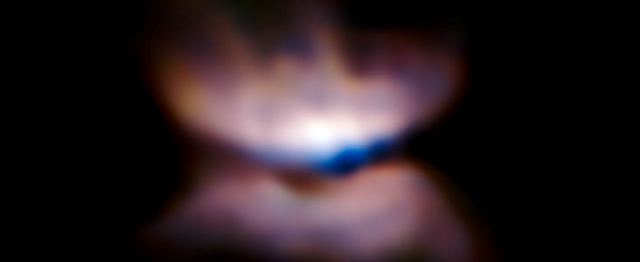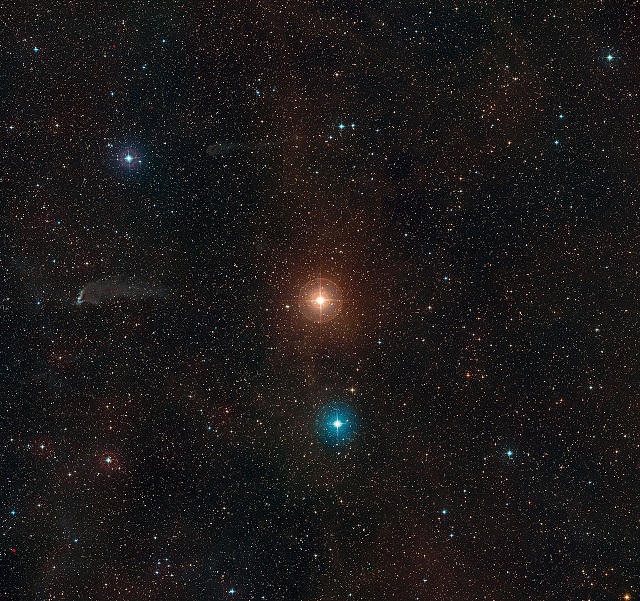Jun 11 2015
 VLT/SPHERE image of the star L2 Puppis and its surroundings
VLT/SPHERE image of the star L2 Puppis and its surroundings
From striking images obtained through ESO’s Very Large Telescope (VLT), astronomers have identified, for the first time, what seems to be the initial stage of a butterfly-like planetary nebula formation from an ageing star. The observations of the red giant star L2 Puppis were carried out in the ZIMPOL mode of the newly installed SPHERE instrument which also revealed a close companion.
Astronomers have been continually perplexed by the dying stages of stars and when this kind of complex bipolar nebulae appears with alluring hourglass figures, it is all the more mysterious. With this new imaging mode showing in-depth details of dying stars, VLT is definitely the sharpest astronomical direct imaging instrument presently available.
L2 Puppis, at around 200 light years away, is one of the nearest red giant stars to Earth which is said to be reaching its final stages of life. The observations made using the ZIMPOL mode of SPHERE were carried out in visible light with the help of extreme adaptive optics.
This helps in adjusting images to a higher degree when compared to the standard adaptive optics thereby providing greater clarity to faint objects and structures near the bright light sources. These observations are the first published results using this mode and the most detailed of all observations carried out on a giant star.
The images produced using ZIMPOL were thrice as sharper as that from the NASA/ESA Hubble Space Telescope such that even the dust surrounding the L2 Puppis was shown in exquisite detail from the new observation.
They are in accordance with the previous findings, carried out using NACO, of the dust arranged in a disc, which can be seen almost completely edge-on from Earth. However, the new results provide a more detailed view of the dust. Based on the polarization information from ZIMPOL, the team also constructed a 3D model of the dust structures.
The dust disc was observed to start around 900 million kilometers away from the star, which is little farther than the distance between Sun and Jupiter. The astronomers discovered an outward flaring of the disc, producing a symmetrical, funnel-like shape around the star.
They also observed the second source of light starting from about 300 million kilometers away from L2 Puppis, which is twice the distance between Earth and the Sun. The close companion seems to be another red giant star with slightly lower mass.

Image Credit: ESO/Digitized Sky Survey 2
The presence of dust in such large quantities around the dying stars in addition to the companion star imply that this is what is actually required for creating a bipolar planetary nebula. Although these elements are mandatory, probably some amount of good fortune is also needed for the subsequent emergence of a celestial butterfly-like nebula from the dusty chrysalis.
The lead author of the paper, Pierre Kervella, explained: “The origin of bipolar planetary nebulae is one of the great classic problems of modern astrophysics, especially the question of how, exactly, stars return their valuable payload of metals back into space — an important process, because it is this material that will be used to produce later generations of planetary systems.”
Besides L2 Puppis’s flared disc, the astronomers also observed two cones of material formed at right angles to the disc. Inside these cones, two long, slowly curving plumes of material were seen.
On seeing the origin points of these plumes, the team inferred that one is likely to be the result of the L2 Puppis material's interaction with the companions star’s wind and radiation pressure, while the other to be the consequence of an accretion disc around the companion star or the collision between the stellar winds from the two stars.
These are the two leading bipolar planetary nebulae theories derived based on the existence of a binary star system, yet there is still more to be interpreted. It is evident from the new observations that both the concepts revolve around L2 Puppis, increasing the probability of birth of a butterfly from the pair of stars.
With the companion star orbiting L2 Puppis only every few years, we expect to see how the companion star shapes the red giant’s disc. It will be possible to follow the evolution of the dust features around the star in real time — an extremely rare and exciting prospect.
Pierre Kervella
The research etitled The dust disk and companion of the nearby AGB star L2 Puppis was published in June 10th edition of the journal Astronomy & Astrophysics.